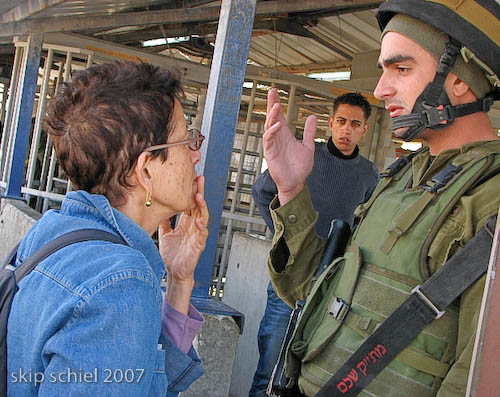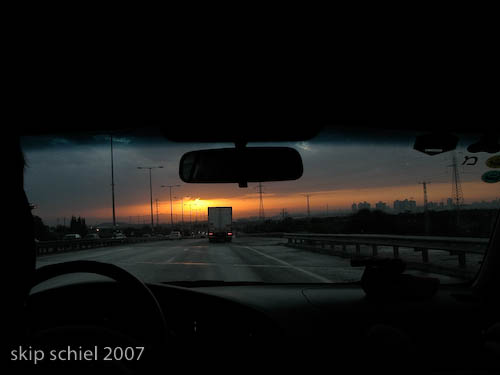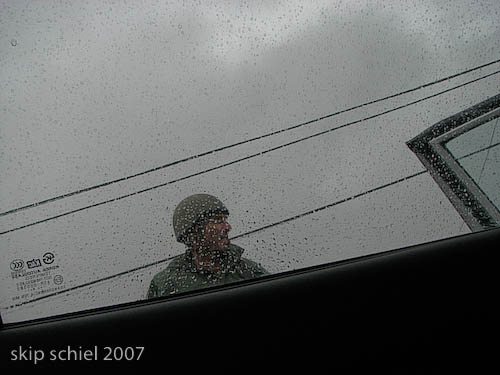In the West Bank with Machsomwatch and Esti Tsal
A friend, Rick, met her earlier thru the Anarchists Against the Wall I believe. She offered to tour Rick, another friend, Marty, and me around some checkpoints that Machsom monitors. Among them Harawwa, south of Nablus, a sometimes horrendous place. This day quiet. Because she was with us I had relatively free access to soldiers for photographing. Because of Machsom the army has drawn white vertical lines to indicate the limits of Machsom’s allowed presence. When she and then Rick tried to test these lines they were told to go back. One soldier in particular, the District Coordination Officer, the man in charge apparently, was friendly, chatted with us, allowed himself to be the topic of my camera .
.
Esti Tsal with District Coordination Officer
We also met the man who’d driven Machsom around different checkpoints when they were initiating the project. They greeted each other exuberantly. 2 older women for the second shift later relieved us. We’d had to arise at 5 AM, meet Esti in Jaffa at 6 for the long drive to our first observation point in the West Bank near Nablus.
Machsom (checkpoint in Hebrew) Watch is an organization of Israeli women volunteers monitoring human rights abuses at checkpoints. There are some 500 checkpoints and roadblocks in the West Bank; the number of women is limited so they’ve selected the most volatile ones to observe and report on. Esti is an accomplished photographer, uses her camera regularly, this day did not. She was one of the coordinators for an exhibit shown in Israel. They’re looking for international venues.
Driving with Israeli plates along the Israeli-only super highway from Tel Aviv to Ariel, one of the largest settlement blocks, demonstrated vividly how invisible the occupation is to most Israelis. Very little sign of entering the West Bank. One sign read something like “dangerous territory.” Occasionally we’d see fences; usually we’d observe distant Palestinian villages with their “picturesque” mosques and minarets—a Disney theme park. We needed a mere 30 minutes or so from Tel Aviv to Ariel, whereas that trip would be impossible for most Palestinians, or if by some miracle there were allowed such a transit between those two points, using non-Israeli roads the time might be hours. A powerful tour would be from the viewpoint of Israelis living in the West Bank and working in Israel.
Tel Aviv to the settlement of Ariel in the West Bank, 20 smooth minutes
The checkpoints passed by settlers have a special passageway for Israeli licenses vehicles. They pass speedily, much like the Fast Pass lanes in the United States.
Israelis are prohibited from many parts of the West Bank, especially area A under Palestinian control. This means most of the cities, including Qalqilia. Esti, of stalwart nature, feisty and outspoken, loving as well, often defies these restrictions. She heated about the illegality and immorality of the occupation. Thus she wanted to show us how its encircling Annexation Wall and its solitary checkpoint strangles Qalqilia, a major West Bank city near the Green Line (Armistice Line of 1949). But soldiers prevented us from entering.
Near the Harawwa checkpoint we stopped to visit with people in a convenience store adjacent to one of the largest army bases in the West Bank. The young man, an employee and life long resident of one of the more extreme settlements, told us this is all Israel, he is happy here, and understood that we might not agree with him. Earlier Esti had given him a t-shirt with “1.20.09” emblazoned on it—the date of Bush’s last day as president. He pulled it out of a metal box, his “safe,” to proudly show it to us. He might have been a Bush supporter, we didn’t inquire.
We entered Ariel freely—the yellow Israeli license plates our passport—and photographed freely, especially at the new College of Samaria and Judea. Esti told us it is open to Israeli Palestinians as well as West Bank Palestinians, part of a ploy she says to make Israel look good. Here’s a quote from their website:
As a demonstratively Zionist institution, the College has two key requirements: every student must study one course per semester on some aspect of Judaism, Jewish heritage or Land of Israel studies, and the Israeli flag must be displayed in every classroom, laboratory and auditorium on campus.
An unexpected discovery: Funduq, near Qalqilia, a small village between the Israeli-only highway and a settlement. In the rain we drove thru on our way to Qalqilia, noticed all the shops closed, not a holiday, we inquired: curfew. The day before someone from another village shot and killed a settler passing thru. Somehow the shooter was caught quickly. The army imposed curfew, they claimed it was to protect the Palestinians threatened by possible retaliation from settlers. We believe that although that might play some role the chief reason is collective punishment.
Entering the village of Funduq under curfew
We noticed a cluster of Palestinian men watching us as we lingered at one small intersection. They seemed to be ducking from us, perhaps thinking we were setters. With much chutzpah, Esti walked toward them to inquire further and take testimony. As is the Palestinian way they invited us to drink coffee with them. They allowed me to photograph fairly freely. We notified the International Solitary Movement who sent someone stationed in Azoon to supporter the villagers. Later we learned settlers seeing vengeance for their colleague’s death had attacked Funduq. Later Esti commented that the village leader might be a collaborator. Evidence: his house, large and grand, and he possesses the only Israeli plates in town.



